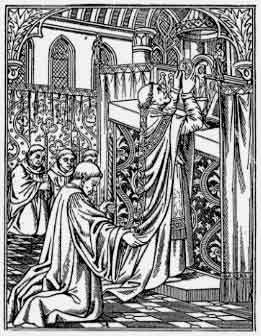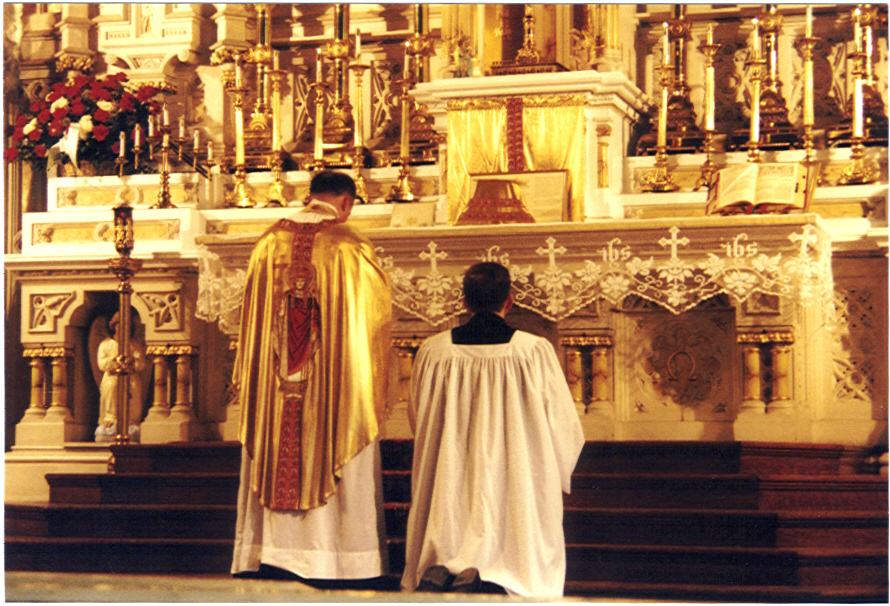Ven. PIE XII : " De fait, les mérites de ce sacrifice, infinis et sans mesure, n’ont pas de limites : ils s’étendent à l’universalité des hommes de tous les lieux et de tous les temps, parce que l’Homme-Dieu en est le Prêtre et la Victime ; parce que son immolation, comme son obéissance à la volonté du Père éternel, fut absolument parfaite, et parce qu’il a voulu mourir comme Chef du genre humain...il faut absolument que chaque homme en particulier entre en contact vital avec le sacrifice de la croix, et donc que les mérites qui en découlent lui soient transmis. On peut dire d’une certaine manière que sur le Calvaire le Christ a établi une piscine d’expiation et de salut, qu’il a remplie de son sang répandu, mais si les hommes ne se plongent pas dans ses eaux et n’y lavent les taches de leurs fautes, ils ne peuvent assurément obtenir purification ni salut. "

Encyclique MEDIATOR DEI
de Sa Sainteté le Pape PIE XII
SUR LA SAINTE LITURGIE
Valeur infinie du divin sacrifice
Il est donc facile de comprendre pourquoi le saint concile de Trente affirme que la vertu salutaire de la croix nous est communiquée par le sacrifice eucharistique pour la rémission de nos péchés quotidiens (cf. Sess. XXII, cap. 1). L’apôtre des Gentils, en proclamant la surabondante plénitude et perfection du sacrifice de la croix, a déclaré que le Christ, par une seule oblation, a rendu parfaits à jamais tous les sanctifiés (cf. He X, 14). De fait, les mérites de ce sacrifice, infinis et sans mesure, n’ont pas de limites : ils s’étendent à l’universalité des hommes de tous les lieux et de tous les temps, parce que l’Homme-Dieu en est le Prêtre et la Victime ; parce que son immolation, comme son obéissance à la volonté du Père éternel, fut absolument parfaite, et parce qu’il a voulu mourir comme Chef du genre humain : " Vois comment fut traité notre rachat : le Christ pend au bois, vois à quel prix il a acheté… il a versé son sang, il a acheté avec son sang, il a acheté avec le sang de l’Agneau immaculé, avec le sang du Fils unique de Dieu… L’acheteur est le Christ, le prix, le sang ; l’achat, le monde entier " (S. Augustin, Enarr. in Ps. CXLVII, n. 16).
Ce rachat, cependant, n’atteint pas aussitôt son plein effet : il faut que le Christ, après avoir racheté le monde au prix très précieux de lui-même, entre effectivement en possession réelle des âmes des hommes. Aussi, pour que leur rédemption et leur salut, en ce qui concerne les individus et toutes les générations qui se succéderont jusqu’à la fin des siècles, se réalisent et soient agréés de Dieu, il faut absolument que chaque homme en particulier entre en contact vital avec le sacrifice de la croix, et donc que les mérites qui en découlent lui soient transmis. On peut dire d’une certaine manière que sur le Calvaire le Christ a établi une piscine d’expiation et de salut, qu’il a remplie de son sang répandu, mais si les hommes ne se plongent pas dans ses eaux et n’y lavent les taches de leurs fautes, ils ne peuvent assurément obtenir purification ni salut.
Mais la collaboration des fidèles est nécessaire
Afin donc que chaque pécheur soit blanchi dans le sang de l’Agneau, les chrétiens doivent nécessairement associer leur travail à celui du Christ. Si, parlant en général, on peut dire, en effet, que le Christ a réconcilié, avec son Père par sa mort sanglante, tout le genre humain, il a voulu cependant que, pour obtenir les fruits salutaires produits par lui sur la croix, tous fussent conduits et amenés à sa croix, par les sacrements principalement et par le sacrifice eucharistique. Dans cette participation actuelle et personnelle, de même que les membres prennent chaque jour une ressemblance plus grande avec leur divin Chef, de même la vie salutaire découlant du Chef est communiquée aux membres, si bien que nous pouvons répéter les paroles de saint Paul : " Je suis attaché à la croix avec le Christ, et ce n’est plus moi qui vis, mais c’est le Christ qui vit en moi " (Gal II, 19-20).
Comme Nous l’avons déjà dit en une autre occasion d’une façon expresse et concise, " Jésus-Christ en mourant sur la croix donna à son Église, sans aucune coopération de la part de celle-ci, l’immense trésor de la Rédemption ; mais quand il s’agit de distribuer ce trésor, non seulement il partage avec son Épouse immaculée cette œuvre de sanctification, mais il veut encore qu’elle naisse en quelque sorte de sa propre activité " (Lettre encycl. Mystici Corporis, du 29 juin 1943).
Or, le saint sacrifice de l’autel est comme l’instrument par excellence par lequel les mérites venant de la croix du divin Rédempteur sont distribués : " Toutes les fois que le souvenir de ce sacrifice est célébré, l’œuvre de notre Rédemption s’accomplit " (Missale Rom., Secreta Dom. IX post Pentec.). Celui-ci, cependant, bien loin de diminuer la dignité du sacrifice sanglant, en fait plutôt connaître davantage et en rend plus évidentes la grandeur et la nécessité comme l’affirme le concile de Trente (cf. Conc. Trid., Sess. XXII, cap. 2 et can. 4).


















.jpg)

.jpg)


